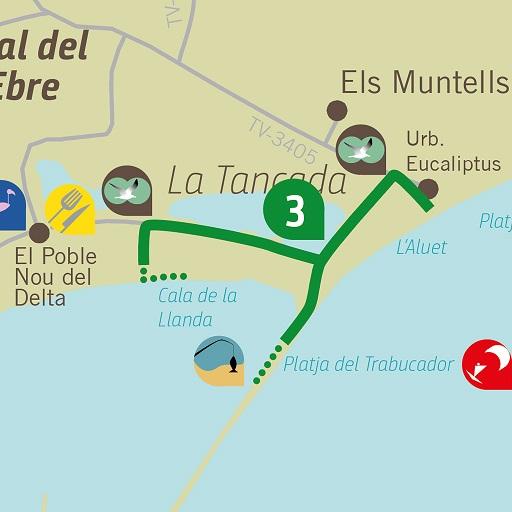Route 3. La Tancada and Els Alfacs bay
Departure point: Urbanització Eucaliptus, Amposta
Duration: half day
Route by car: 11,2 km
Route on foot: 5,2 km
Circular: no
This route covers saline environments, starting from the Eucaliptos urbanization and its leafy avenue, which used to be part of an old campsite and which is where a large number of small migratory birds stop and where scops owls and long-eared owls hide. Head towards the TV-3405 road, where you can stop at Riet Vell to see up-close a good number of birds typical of the lagoons and take pictures. Then, take the paved track that crosses the Erms de la Tancada, salty lands dominated by glasswort plants where migrators stop, especially after flying in easterly winds, it is also where the only populations of Mediterranean short-toed larks can be found outside the Secanos de Lleida (Lleida drylands). This is a great place to try your luck by waiting for the last moments of daylight to spot the short-eared owl. On arrival at the Tancada lagoon, large flocks of flamingos brighten up the landscape. Check every lamppost and telephone pole because it is not uncommon for ospreys to to be seen there gobbling up freshly caught fish.
Next, you enter the Trabucador isthmus, where the one side is open sea and full of marine birds such as the gannet or Mediterranean shearwater, and looking on the other side at the bay there are large numbers of great crested grebes and black-necked grebes, apart from the three loon species: the great, the arctic and the small. If you want to walk, you can walk along the entire sandbar until you reach the entrance of the Salinas (salt flats) and the Punta de la Banya Partial Nature Reserve, a real paradise where countless birds nest and winter, among which are Audouin's gull, the Mediterranean gull, common tern, the sandwich tern, the avocet or the common shelduck. Remember that there is restricted access here.
Now, return to Laguna de la Tancada (lagoon) and go up the road due north towards Poble Nou del Delta passing through the old Salinas de Sant Antoni (salt flats) where Caspian terns, gray plovers and many other species are concentrated, as well as bold flamingos that will delight photographers as long as they aren't disturbed. Shortly after passing the Tancada campsite there is a small track to the left that brings us closer to the Magdalenas sector and the Torre de Sant Joan (tower), where we can see species typical of the bay at a shorter distance and in better conditions. The ideal place to make good observations of great loons in the winter months.
Phenology:
The bays at the Delta are especially interesting between November and March from an ornithologist's point of view. But the beaches and muddy areas host a great diversity of migratory birds both in pre and post-nuptial periods. At the same time, the main breeding colonies of terns and seagulls are found in Punta de la Banya, making the nearby waters feeding places for these birds. Therefore, in every month of the year there are great opportunities to enjoy bird watching on this route.
Track GPX
We also make the route file available to you in gpx format so that you can use it with your GPS device (see link in the header).






